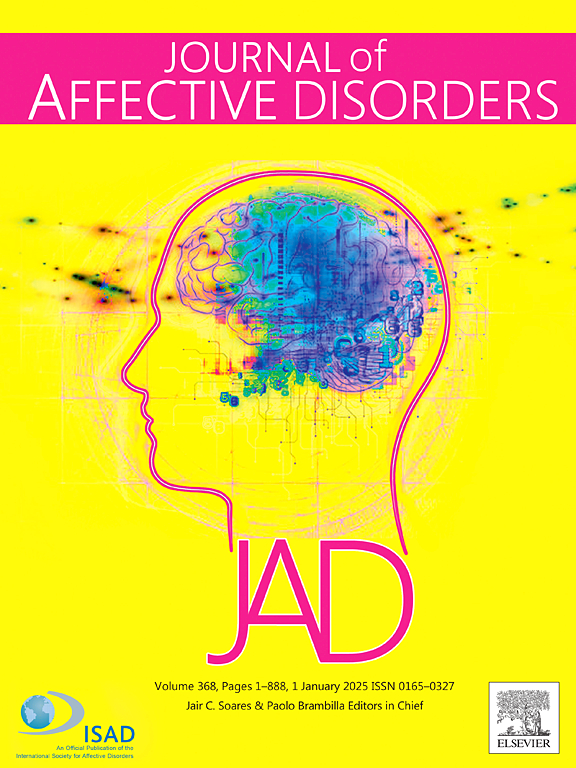Serum HDL mediates the association between inflammatory predictors and depression risk after the COVID-19 pandemic
IF 4.9
2区 医学
Q1 CLINICAL NEUROLOGY
引用次数: 0
Abstract
Background
This study investigated whether HDL cholesterol mediates the relationship between inflammatory indicators and depression, using post-pandemic data in the context of metabolic disturbances and immune system impairment potentially caused by COVID-19.
Methods
This cross-sectional study, using data from the National Health and Nutrition Examination Survey (NHANES), included 5731 participants aged 20 years or older from August 2021 to August 2023. The Patient Health Questionnaire-9 (PHQ-9) assessed depressive symptoms. Multivariable logistic regression, Pearson correlation, and mediation analyses were conducted to evaluate odds ratios and associations between inflammatory indicators and depression.
Results
Correlation analysis revealed significant negative associations between four inflammatory indicators (CRP, C-reactive protein; PC, platelet count; SII, systemic immune-inflammation index; PPN, product of platelet count and neutrophil count) and HDL cholesterol, as well as between HDL cholesterol and depression, while the inflammatory indicators were significantly positively correlated with depression (all p < 0.05). Furthermore, multivariable logistic regression models, adjusted for covariates, demonstrated that elevated levels of these four inflammatory indicators (CRP: adjusted OR = 1.011, CI = 1.003–1.025; PC: OR = 1.002, CI = 1.001–1.004; SII: OR = 1.002, CI = 1.001–1.003; PPN: OR = 1.002, CI = 1.001–1.004) were significantly associated with an increased risk of depression in the total study population. Finally, mediation analysis indicated that HDL cholesterol mediated the presumed causal associations between CRP (6.7–13.2 %), PC (4.5–12.8 %), PPN (4.8–14.9 %), and depression, whereas SII was identified as an independent predictor of depression development.
Conclusions
Targeting HDL cholesterol and inflammatory indicators such as CRP, PC, SII and PPN may provide potential interventions for mitigating depression risk.
COVID-19大流行后血清HDL介导炎症预测因子与抑郁风险之间的关联
本研究利用COVID-19可能引起的代谢紊乱和免疫系统损伤的大流行后数据,调查高密度脂蛋白胆固醇是否介导炎症指标与抑郁之间的关系。方法本横断面研究使用来自国家健康与营养检查调查(NHANES)的数据,包括2021年8月至2023年8月期间5731名20岁及以上的参与者。患者健康问卷-9 (PHQ-9)评估抑郁症状。采用多变量logistic回归、Pearson相关和中介分析来评估炎症指标与抑郁之间的比值比和相关性。结果4项炎症指标(CRP、c反应蛋白;PC,血小板计数;SII,全身免疫炎症指数;PPN(血小板计数和中性粒细胞计数的乘积)和HDL胆固醇,以及HDL胆固醇与抑郁之间的关系,而炎症指标与抑郁呈显著正相关(均p <;0.05)。此外,校正协变量的多变量logistic回归模型显示,这四种炎症指标水平升高(CRP:校正OR = 1.011, CI = 1.003-1.025;Pc: or = 1.002, ci = 1.001-1.004;Sii: or = 1.002, ci = 1.001-1.003;在整个研究人群中,PPN: OR = 1.002, CI = 1.001-1.004)与抑郁风险增加显著相关。最后,中介分析表明HDL胆固醇介导了CRP(6.7 - 13.2%)、PC(4.5 - 12.8%)、PPN(4.8 - 14.9%)和抑郁症之间的推定因果关系,而SII被确定为抑郁症发展的独立预测因子。结论针对HDL - c、CRP、PC、SII、PPN等炎症指标可能是降低抑郁风险的潜在干预措施。
本文章由计算机程序翻译,如有差异,请以英文原文为准。
求助全文
约1分钟内获得全文
求助全文
来源期刊

Journal of affective disorders
医学-精神病学
CiteScore
10.90
自引率
6.10%
发文量
1319
审稿时长
9.3 weeks
期刊介绍:
The Journal of Affective Disorders publishes papers concerned with affective disorders in the widest sense: depression, mania, mood spectrum, emotions and personality, anxiety and stress. It is interdisciplinary and aims to bring together different approaches for a diverse readership. Top quality papers will be accepted dealing with any aspect of affective disorders, including neuroimaging, cognitive neurosciences, genetics, molecular biology, experimental and clinical neurosciences, pharmacology, neuroimmunoendocrinology, intervention and treatment trials.
 求助内容:
求助内容: 应助结果提醒方式:
应助结果提醒方式:


